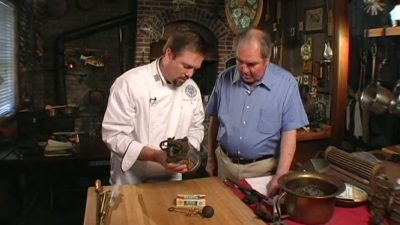Videos in an Online Exhibit: Culinary Curiosity

Videos enrich the modality of online exhibits by adding movement, tempo, and sound to accompany still images and text. The Culinary Curiosity exhibition website hosted by Kendall College in Chicago offers a good example of how videos can communicate knowledge that would be difficult to convey with still media alone. Launched in 2010, Culinary Curiosity showcases a range of historic culinary tools to tell the story of change in food processing technologies since the nineteenth century. Videos at the site demonstrate the use of old or obscure kitchen gadgets (like this universal mayonnaise mixer) whose inner workings could otherwise be difficult to recognize.
Although the videos at Culinary Curiosity are by no means big-budget productions, they use several techniques to convey information effectively. Most videos feature collection donor Mel Mickevic along with a representative of Kendall College or the exhibition curator, using an interview format slightly reminiscent of the popular television series Antiques Roadshow to generate dialog about each object’s history and function. Changing close up shots focus attention on the object elements and details that come up in conversation. Most crucially, videos show the culinary tools in motion, demonstrating how each piece is used and how its components interact. Finally, the videos are offered in short segments — usually just one to five minutes — allowing visitors to engage with the site at their own pace without needing to reserve time for a single long film.
Videos are not the only feature that makes Culinary Curiosity a successful online exhibition. Each object is also displayed with essential metadata, concise but well-written text descriptions, and zoom-able still images. The website provides users multiple ways to browse items, both by thematic display category and by culinary technique. The site even features a quiz allowing users to test their new knowledge after viewing the exhibition.
Despite its many effective elements, Culinary Curiosity does show its age in a few places and leave room for improvement in others. Although well designed for desktops and laptops, the site does not adjust responsively to fit mobile devices — a greater concern now than when it launched in 2010. A slightly larger font size would make text more readable throughout the site, especially on small screens. In addition, the home page consists of nothing but a slideshow of images that does little to guide users toward other parts of the site. It might be more useful to use the current View Exhibit page as the primary home page for the site.
The videos at Culinary Curiosity could also benefit from a few improvements. A few videos at the site feature multiple objects, such as one covering an asparagus cutter-buncher, a magic marmalade cutter, and a stringbean cutter. Videos like this could be cut into segments or at least linked to at different start times for each item, so that viewers can jump directly to each object. Unfortunately, the videos at the site require users to have a proprietary browser plugin, Adobe Flash, which is steadily approaching obsolescence and may make the clips inaccessible to users of certain mobile devices and operating systems. HTML5 video would provide a more modern, plugin-free video technology for current and forthcoming devices. Finally, adding subtitles or transcripts to the videos, while labor intensive, would make the site more accessible to users with disabilities and more easily searchable for researchers.
Overall, regardless of a few weaknesses showing the need for maintenance to keep up with evolving web technologies, Culinary Curiosity is an excellent example of how online history exhibits can utilize relatively simple video productions to add new dimensions of motion, demonstration, and meaning to otherwise static collections of objects.